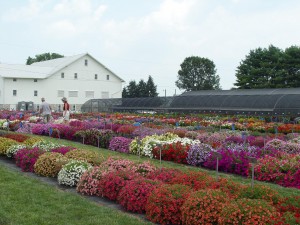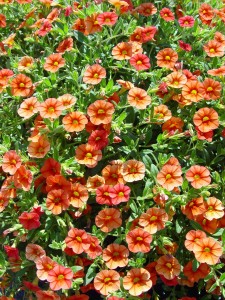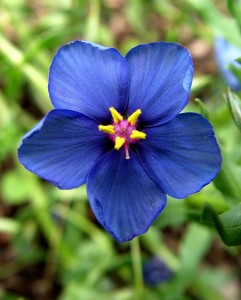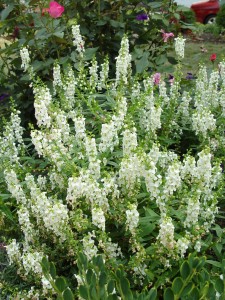Not Your Grandma’s Flowers
May 10th, 2007
Mention “annual flowers” these days, and a lot of gardeners turn up their noses.
“Aren’t they the ones you have to plant every year?” they’ll ask. “No, I don’t want any of those.”
Too bad, because most annuals deliver non-stop color from planting time (now) until frost – and color is something most people say they want more of in the yard.
What’s especially unfortunate is that this annual snub comes at a time when we’ve never had more choices or better performing annual flowers.

Penn State's Trial Gardens near Landisville, Lancaster County.
“Across the board, selections have been increasing in compactness, flower production and disease prevention,” says Alan Michael, director of the huge annual trial garden at Penn State University’s Southeast Agricultural Research and Extension Center near Landisville, Lancaster County. “We’ve been seeing tremendous improvements.”
Today’s annuals are a far cry from yesteryear’s petunias that turned to mush after a rain, or the old, overplanted red geraniums that would put out a few meager flower heads that required constant decapitating after they browned.
Yet many gardeners skip past the garden center’s annual benches in favor of perennial flowers – the ones that come back year after year.
While that might sound like a great time-, money- and work-saver, it doesn’t always work out that way.
Says Michael: “I ask people, ‘How does your perennial garden look three years after planting? When was the last time you divided?’ Unless you’re very good at design, there’s too much down time in a perennial garden.”
Unlike annuals – which often bloom non-stop right up until the day that fall frost kills them – most perennials only bloom for a few weeks out of the whole season. (Another option there: Perennials that have colorful foliage.)
Michael says this shouldn’t be an all-or-nothing deal.
“You don’t have to plant a whole bed full of annuals,” he says. “You can plant some in with the perennials.”
Michael says annuals also are great for adding spots of season-long color anywhere in the landscape and for growing in flower pots and hanging baskets.
As a tradeoff for all the color, annuals do need good soil, adequate water (especially the first few weeks after planting) and several doses of fertilizer throughout the season for maximum performance.
Michael says breeders have made huge strides lately in improving older types of annuals, but they’ve also introduced lots of interesting new species that do extremely well in Pennsylvania summer gardens.
He cites three reasons:
1.) Improved genetics, which has allowed breeders to cross varieties they were never able to cross before.
2.) A move to reproduce plants more by stem cuttings instead of seeds, which has quickened the pace of new-plant development and evaluation.
3.) A worldwide increase in breeding new plants for the U.S. market. Michael says many of our new introductions are coming from breeding work in Israel, the Netherlands, Germany, China and Japan.
Not all that’s new is better, though. The main purpose of trial gardens such as Penn State’s is to sort through hundreds of new varieties every year to see which few really are worthy of elbowing out space on tomorrow’s garden-center benches.
“I’d say maybe 25 percent of what comes in is outstanding, and the rest is just average,” says Michael, who rates each test variety several times throughout the growing season.
He also cautions that not all colors of a particular new line are equal. Just because a new ‘Sanguna White’ petunia turns out to be a super performer doesn’t mean ‘Sanguna Purple’ will, too.
Wholesale growers are especially interested in seeing these trials to help them decide what to grow. The trial grounds are open to the public as well. (See below for details.)

Calibrachoa 'Superbells Dreamsicle'
Two of Michael’s favorites that still draw blank stares from most people are scaevola and calibrachoa.
Although it’s been around for years, scaevola is an under-used trailer that gets purple or blue-purple star-shaped flowers. “It’s very vigorous and covers the ground really well,” says Michael. “There’s hardly a bad one out there. And it doesn’t need a lot of fertilizer.”
Calibrachoa is a petunia look-alike that comes in all sorts of colors ranging from basic pinks and golds to interesting pastels such as peach, apricot and terra-cotta.
Michael also is a fan of angelonia, an upright, spiky annual with purple, blue, white or pink flowers that are reminiscent of orchids. “‘Serena’ is a great new series that blooms early, stays short and is never out of bloom,” he says.
Many of the latest, greatest annuals deliver their color from the leaves instead of the flowers.
Most familiar to gardeners is coleus, a Victorian-era favorite that’s been making a huge comeback because of its bright colors and ease of growth.
Dozens of new coleus varieties have been introduced in the last few years, mostly in eye-popping variegations that blend combinations of red, burgundy, green, lime, gold and rose. Many of the new coleus do just as well in full sun as shade – their former preference.
But coleus is far from the only great foliage choice.
Many gardeners are just discovering alternanthera, a diverse species of colorful-leafed annuals that range from low-growers with spiky red leaves (‘Red Threads’) to dark-leafed vines (‘Purple Knight’) to pink, cream and green variegated trailers that look a bit like poinsettias (‘Party Time’).
Also just catching on is graptophyllum, a line of dark-leafed upright annuals (‘Tricolor,’ ‘Chocolate’ and ‘Black Beauty’ are three varieties), and a bushy herb called perilla ‘Magilla’ that has leaves with a kaleidoscopic blend of green, pink, dark rose and cream.

Closeup of anagallis flower.
Penn State’s beds are filled with these and other gems that few gardeners know – species such as cobalt-blue-blooming anagallis; trailing, pastel-flowered diascia, and a creeping zinnia look-alike called sanvitalia.
These grow in pots in long, wide rows over several acres of Lancaster County farmland along with more familiar flowers such as impatiens, begonias, petunias, verbena and geraniums.
But whether they’re new-fangled old favorites or strange newcomers, they’re all a far cry from your Grandma’s flowers.
See new annuals in action before buying:
Penn State University’s Southeast Agricultural Research and Extension Center near Landisville, Lancaster County, offers a sneak peek each summer at some of tomorrow’s new annual flowers.
Hundreds of potential new varieties are test-grown alongside recent introductions to see how well they perform in Pennsylvania’s climate.
The trial gardens are free and open to the public. Plants are labeled, and the best months to see the plants in bloom are July and August.
To get there from Harrisburg, take Route 283 east toward Lancaster and get off at the Esbenshade Road exit. Turn left off the ramp and take the first right onto Auction Road.
Go about 1 mile to the stop sign and turn right onto Erisman Road. Take the first left – just before crossing a bridge – back onto Auction Road. Then take the first left into the center’s driveway, marked by a Penn State sign.
For a map and more details on the center plus pictures of some of the top recent varieties, visit online at http://trialgardens.cas.psu.edu.
Ten of my favorite annual flowers for Harrisburg-area gardens:
1.) ‘Black Pearl’ hot pepper. An action-packed pepper with jet-black leaves, lavender bell-shaped flowers and shiny, olive-like black fruits that ripen red.
2.) ‘Dragon Wing’ begonia. A tough but beautiful arching plant with hanging red or pink flowers and glossy, serrated leaves with deep-red undersides.
3.) ‘Blue Wave’ or ‘Pink Wave’ petunia. Heavy bloomers that spread 2 feet or more and flower all along the stems, not just the tips. The former is deep purple, the latter medium pink.
4.) ‘Profusion Fire’ zinnia. A bushy, 18-inch zinnia that blooms heavy and non-stop in burnt orange. Doesn’t flop or get mildew like older zinnias.
5.) ‘Kong Rose’ coleus. A foliage annual with hand-sized leaves that are a beautiful blend of golden-yellow and burgundy.

Angelonia 'Serena White'
6.) ‘Serena White’ angelonia. A foot-tall, upright bloomer with dainty spikes of white orchid-like flowers.
7.) ‘Signum’ blue salvia. A tough and rabbit-proof, 18-inch-tall upright bloomer with blue-purple flower spikes.
8.) ‘Jaio Scarlet Eye’ vinca. A heat-tolerant, rabbit-proof annual with quarter-size rounded flowers of deep, bright rose with white centers.
9.) ‘Prairie Sun’ or ‘Tiger Eye’ rudbeckia. Annual black-eyed susan with neon-gold petals around a central cone. Eye-popper from late summer on.
10.) ‘Pixie Pink Bicolor’ mini-impatiens. Compact and cute but heavy-blooming shade annual with dainty pink and white flowers.
All-America annuals:
Another good way to determine if an annual flower really is a superior performer is to look for varieties that have won All America Selections awards.
This 75-year-old national testing program conducts trials of hundreds of new varieties every year at trial gardens across the country – many of them at university test sites (including Penn State). Researchers evaluate and score each variety, and only the very few of the best of the best earn AAS awards.
“Most of these plants do very well in home gardens – particularly ones that have won in the last 10 years,” says Alan Michael, director of Penn State’s trial gardens in Lancaster County.
All of the winners since 1933 are listed online at the AAS web site at www.aaswinners.com.
Varieties that have won awards also usually have AAS logos imprinted on their signage and/or plant tags at garden centers.







